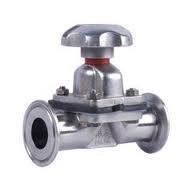Diaphragm Valves

Das Diaphragm Valves are designed and manufactured of superior and export quality. Diaphragm valves are suitable for handling sticky and viscous fluids, slurries and highly corrosive and hazardous substances. It is needless to say that they could be used for handling air, water and normal liquid/gas flow as well. It is the most ideal valve to handle fluids that require high purity and should remain free from contamination. Diaphragm valves (or membrane valves) consists of a valve body with two or more ports, a diaphragm, and a "weir or saddle" or seat upon which the diaphragm closes the valve. The valve is constructed from either plastic or metal. Originally, the diaphragm valve was developed for use in industrial applications. Later on the design was adapted for use in the bio-pharmaceutical industry by using compliant materials that can withstand sanitizing and sterilizing methods. There are two main categories of diaphragm valves: one type seals over a "weir" (saddle) and the other (sometimes called a "full bore or straight-way" valve) seals over a seat. The weir or saddle type is the most common in process applications and the seat-type is more commonly used in slurry applications to reduce blocking issues but exists also as a process valve. While diaphragm valves usually come in two-port forms (2/2-way diaphragm valve), they can also come with three ports (3/2-way diaphragm valves also called T-valves) and more (so called block-valves). When more than three ports are included, they generally require more than one diaphragm seat; however, special dual actuators can handle more ports with one membrane. Diaphragm valves can be manual or automated. Their application is generally as shut-off valves in process systems within the industrial, food and beverage, pharmaceutical and biotech industries. The older generation of these valves is not suited for regulating and controlling process flows, however newer developments in this area have successfully tackled this problem. In addition to the well known, two way shut off diaphragm valve, other types include: Three way zero deadleg valve, sterile access port, block and bleed, valbow and tank bottom valve. Ball valves are used extensively in industrial applications because they are very versatile.